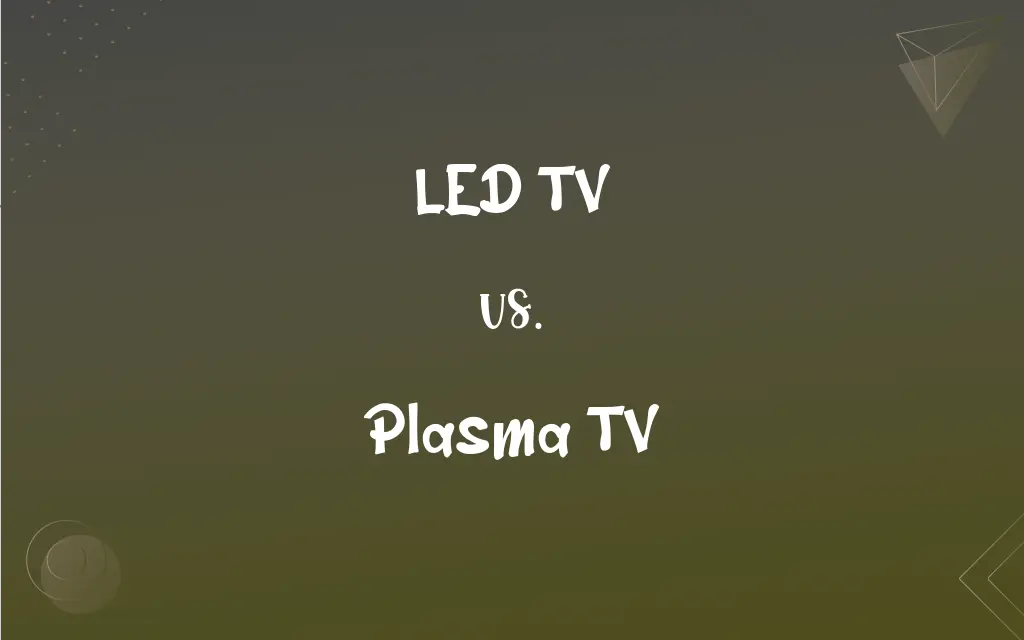LED TV vs. Plasma TV: What's the Difference?
Edited by Janet White || By Harlon Moss || Published on January 13, 2024
LED TVs use light-emitting diodes for backlighting, offering energy efficiency and slim design; Plasma TVs use plasma cells for display, known for deep blacks and wide viewing angles.

Key Differences
LED TVs, utilizing light-emitting diodes, are known for their energy efficiency and slim profile. Plasma TVs, on the other hand, create images using plasma cells and are praised for their deep black levels and color accuracy.
LED TVs often have a brighter display and are more suitable for well-lit rooms. In contrast, plasma TVs provide superior viewing angles and better performance in dimly lit environments.
The lifespan of LED TVs tends to be longer than that of plasma TVs, which can suffer from issues like screen burn-in and fading over time. LED technology also allows for a wider range of sizes, from very small to very large screens.
Plasma TVs generally offer better motion handling, making them a preferred choice for action movies and sports. LED TVs, however, have made significant advancements in reducing motion blur.
In terms of cost, LED TVs cover a broad range, making them accessible to various budgets. Plasma TVs were typically more expensive, especially in larger sizes, and are no longer widely produced.
ADVERTISEMENT
Comparison Chart
Technology
Light-emitting diodes for backlighting
Plasma cells for image creation
Energy Efficiency
More energy-efficient
Less energy-efficient
Display Brightness
Brighter display
Better in dim lighting
Lifespan
Longer lifespan
Shorter lifespan, prone to burn-in
Motion Handling
Good, with recent improvements
Excellent, ideal for fast-moving scenes
ADVERTISEMENT
LED TV and Plasma TV Definitions
LED TV
An LED TV uses diodes for backlighting the screen.
The LED TV provided clear images even in a bright room.
Plasma TV
Plasma TVs perform well in dimly lit environments.
Watching a horror movie was ideal on the plasma TV.
LED TV
It's known for energy efficiency and a slim design.
The slim profile of the LED TV made it perfect for wall mounting.
Plasma TV
A plasma TV uses plasma cells for its display.
The plasma TV displayed deep black levels in the movie.
LED TV
They have a longer lifespan compared to plasma TVs.
Their LED TV lasted for over a decade without issues.
Plasma TV
They excel in displaying fast-moving scenes.
The sports game looked exceptionally fluid on the plasma TV.
LED TV
LED TVs offer a wide range of screen sizes.
They bought a large 65-inch LED TV for their living room.
Plasma TV
Plasma TVs were once preferred for their picture quality.
The plasma TV had a picture quality admired by enthusiasts.
LED TV
LED TVs are more suitable for brightly lit rooms.
The brightness of the LED TV was adjustable for daylight viewing.
Plasma TV
It offers superior viewing angles and color accuracy.
The colors on the plasma TV remained vibrant from all angles.
FAQs
How does LED backlighting improve picture quality?
LED backlighting enhances contrast, brightness, and color range compared to traditional LCDs.
Are there different types of LED TVs?
Yes, mainly Edge-Lit and Full-Array (or Direct-Lit) LED TVs.
Are LED TVs good for gaming?
Yes, with low input lag and high refresh rates, they are suitable for gaming.
Do LED TVs save energy?
Yes, LED TVs are more energy-efficient than Plasma and traditional LCD TVs.
How thin can LED TVs be?
They can be incredibly slim, often less than an inch thick.
How does a Plasma TV perform in bright rooms?
They can struggle with glare and reflections due to glass screens.
What is an LED TV?
An LED TV uses Light Emitting Diodes (LEDs) for backlighting the display.
What is an Edge-Lit LED TV?
It has LEDs along the edges of the screen, allowing for a thinner design.
What is a Full-Array LED TV?
It has LEDs across the entire back panel, offering better picture uniformity.
Can LED TVs be affected by screen burn-in?
No, screen burn-in is not an issue with LED TVs.
What is a Plasma TV?
A Plasma TV uses small cells containing electrically charged ionized gases to produce the picture.
What are the advantages of Plasma TVs?
They offer high contrast ratios, deep blacks, and wide viewing angles.
Are Plasma TVs still being manufactured?
As of my last update in April 2023, they have largely been phased out in favor of LED and OLED technologies.
How energy-efficient are Plasma TVs?
They are less energy-efficient compared to LED TVs.
Are Plasma TVs heavier than LED TVs?
Yes, they tend to be heavier and thicker.
How long do LED TVs last?
They typically last about 60,000 to 100,000 hours.
What is the lifespan of a Plasma TV?
Around 60,000 hours, similar to LED TVs.
Do Plasma TVs offer good motion handling?
Yes, they are excellent for displaying fast-moving images without motion blur.
Do Plasma TVs have a burn-in problem?
Yes, earlier models were more prone to burn-in, though it's less of an issue with newer models.
Can Plasma TVs work at high altitudes?
High altitudes can affect the performance of Plasma TVs due to pressure differences.
About Author
Written by
Harlon MossHarlon is a seasoned quality moderator and accomplished content writer for Difference Wiki. An alumnus of the prestigious University of California, he earned his degree in Computer Science. Leveraging his academic background, Harlon brings a meticulous and informed perspective to his work, ensuring content accuracy and excellence.
Edited by
Janet WhiteJanet White has been an esteemed writer and blogger for Difference Wiki. Holding a Master's degree in Science and Medical Journalism from the prestigious Boston University, she has consistently demonstrated her expertise and passion for her field. When she's not immersed in her work, Janet relishes her time exercising, delving into a good book, and cherishing moments with friends and family.






































































